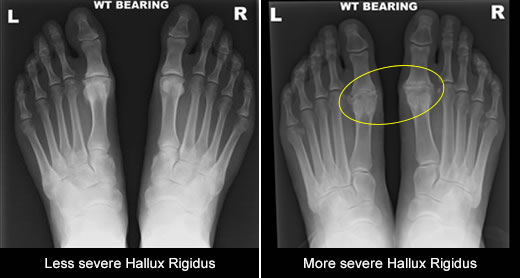
Arthritis of the Big Toe Joint (Hallux Rigidus)
What Is The Problem?
Arthritis of the big toe joint is at the 1 for this is hallux rigidus. Arthritis occurs when the soft cartilage lining of the joint wears out and bone moves against bone instead. This is painful. New bone can form called osteophytes and these can pinch against the surrounding soft tissues causing pain. The joint then becomes painful and stiff.
You may have pain directly from the joint or pain from the pressure of shoes on the swollen joint.
Do I Need To Have Treatment?
If your foot is not painful then treatment is not recommended.
What Are The Treatment Choices?
Non – Surgical
The first line of treatment is to alter your footwear and try painkillers. A shoe with a stiffer sole reduces toe movements or a shoe with a rocker bottom may help. Calluses (hard skin) under the big or lesser toes can be trimmed. Soft pads may help relieve pain from these.
Surgical
If the non-surgical treatment does not help then surgery maybe an option. The main aim of surgery is to reduce your pain. The prominent bone on the top of the joint can be removed. The aim is to stop the tissues pinching when you move your big toe but it does not remove the arthritis or prevent it. This procedure is called a dorsal cheilectomy.
There is no reproducible procedure to replace the worn cartilage in the joint. Therefore the main treatment is to fuse (medically called an arthrodesis) the joint. This converts a painful stiff joint with little movement to a painless and permanently stiff joint with no movement. Screws, staples or plates are used to hold the bones in position. With a fusion it is unlikely you will be able to wear high heels or play active sports again. This surgery can be done under general anaesthetic (asleep) or regional anaesthetic block (awake). You may be able to go home that day or may require an overnight stay in the hospital. These decisions depend on your health and situation at home. A decision will be made with you.
After the surgery you will be able to put weight on your foot when wearing a special shoe. It is important to keep your foot elevated and dry for the first two weeks. This reduces the swelling and helps the wound heal. You will be
seen at approximately two weeks to have the wound reviewed. If you have had a cheilectomy it is important to gently move your toes to prevent stiffness. You will also be seen at approximately six weeks for an x-ray if you have had a fusion. When the bones have fused you will be able to return to your normal footwear. Often a sandal is required for
a few weeks to accommodate the swelling. If takes six months to recover from the surgery and occasionally a year.
Are There Complications?
With any surgical procedure there is a chance of a complication. Every effort is made to minimise the possibility. The complications include:
Infection: Infections may settle with antibiotics but if serious surgery may be required.
Swelling: Most swelling resolves but some may have permanent swelling.
Scar pain: A scar can be painful and sensitive. When the wound has healed and is dry, gentle massage with a moisturiser helps.
Long term pain: For this reason surgery is not done for cosmetic reasons.
Non Union: The bones may not heal after surgery. The biggest risk for this is in smokers. Further surgery is often required in this scenario.
Mal Union: The bones heal in the incorrect position. The toe may rub against footwear. Further surgery may be required.
Blood clots: The risk of a blood clot in your calf (deep vein thrombosis) or lungs (pulmonary embolus) is rare after this surgery. Please inform the team if you have had one of these previously as this increases your risk.
Numbness/Tingling: Usually this resolves, but it may be permanent.
Recurrent deformity/Over correction: In both of these situations further surgery may be required.
Metal ware breaking/Prominence: It is rare for the metal to break but when the swelling settles it may be prominent.
